Bavaria C38, Dufour 390, Hanse 388: Three cruising yachts around eleven metres in comparison
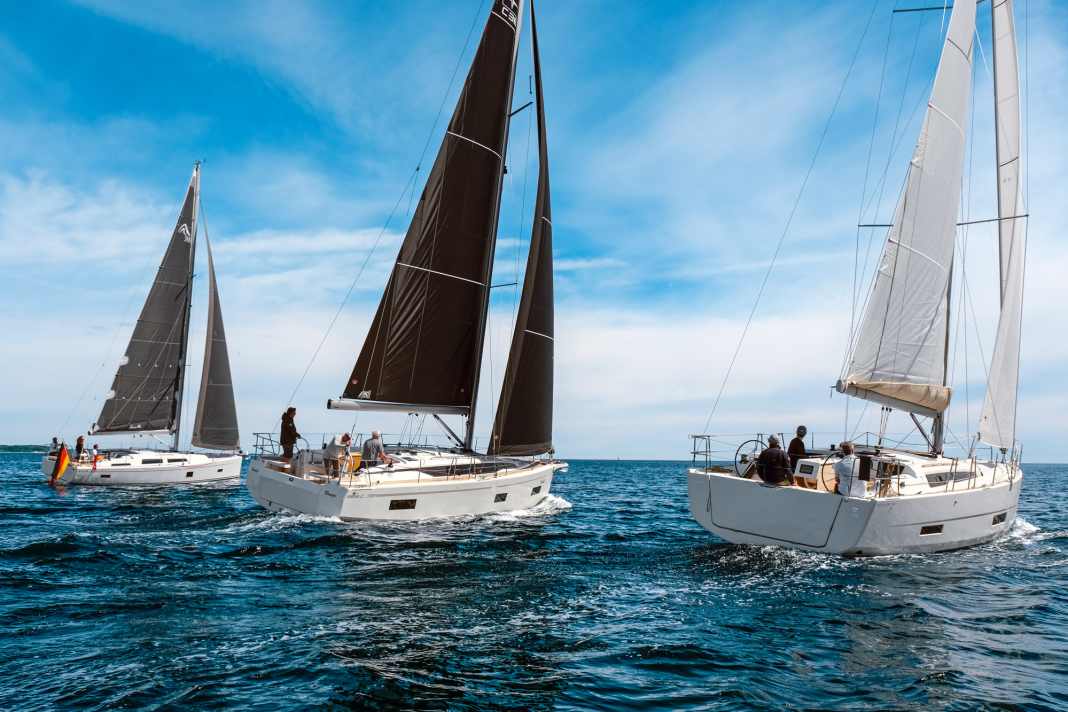





In this article:
Every year - the YACHT group tests in Neustadt on the Baltic Sea have become part of the annual editorial programme of Europe's largest sailing magazine. Planned to take place after the Hamburg Ancora Yachtfestival trade fair, the class comparisons have helped shape the magazine's content in recent years. In 2020 it was the 40-foot deck saloon yachts, in 2019 the 45 cruisers, and before that the ten-metre performance boats and the popular tourers in the entry-level class. Last year, six 12-metre performance cruisers competed against each other.
The plan for the 2021 comparison was: the 38-foot cruisers from the major shipyard series of the "big five". In other words, the then current eleven-metre boats from Bavaria, Beneteau, Dufour, Hanse and Jeanneau. The aim was to get a group of five boats together. Three of them took part, which is quite remarkable given the pandemic and the associated difficulties in the shipyards. The Bavaria C38, the Dufour 390 and the Hanse 388 came to Neustadt for the collective test.
The cruising yachts in the individual test:
The size segment is of particular interest because the boats around eleven metres hull length offer comparable ship concepts in all cases. The 38-footers from the leading shipyards all present themselves as somewhat smaller, more manageable and therefore also cheaper derivatives of their larger sisters from the twelve metre hull length class (40/41 feet), which is also very popular for yacht charters. Essentially, the boats have only been slightly reduced in size, apart from a few details. The layout variants also remain similar, in some cases even almost identical. And the smaller boats are less than four metres wide, which can be a major issue in many harbours.
Nevertheless, the designation 38 feet is misleading. With a hull length of 10.99 metres, the comparison boats Bavaria C38 and Hanse 388 actually only measure 36 feet. The Dufour 390 is slightly longer than the competition (11.20 metres) and therefore just under 37 feet. So the manufacturers in this class are all cheating a little when it comes to type labelling.
Modern lines with plenty of volume
The Bavaria C38 and Dufour 390 models represent the modern yacht design with striking and forward-drawn chine edges, very wide sterns and great fullness in the bow area. Their freeboards are high and slope almost vertically in favour of more volume for the interior fittings. The Hanse 388, on the other hand, is a complete reworking of the Hanse 385 from 2011 and is somewhat older with more conventional lines. Her hull is a little narrower and constricts more at the stern. In addition, the freeboard is lower and the frame is moderately round throughout, even aft at the stern.
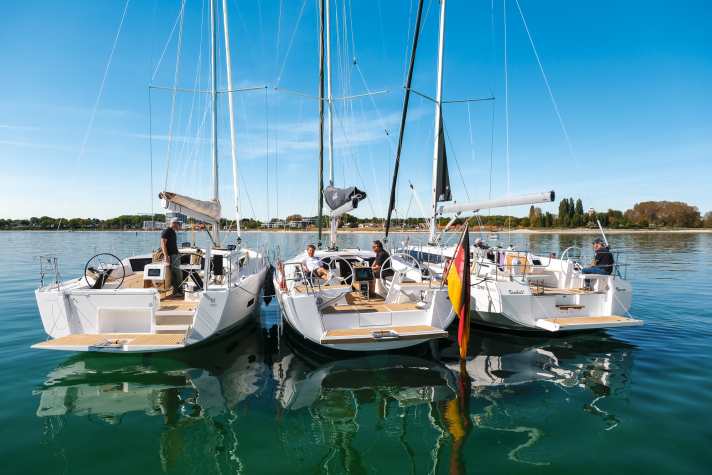
In a purely visual comparison, the Judel/Vrolijk & Co. design is therefore the more delicate, elegant and harmonious yacht. The Bavaria and Dufour models are more angular and radical on the outside and, above all, more massive, especially the ship from Giebelstadt designed by the Italian Maurizio Cossutti. The plans for the Dufour also come from Italy. Umberto Felci has been the French company's design partner for many years.
There are no variable draughts for cruising yachts
There is uniformity within the test group with regard to the hull appendages. In comparison, all ships retain the fixed L-shaped cast iron keel and a rudder blade. Movable solutions such as swivelling or lifting keels are not provided. There are also only modifications for the draughts. The standard keels extend downwards by two metres, while the optional flat keels are 20 (Dufour) to 40 centimetres (Bavaria and Hanse) shorter.
The French competitors from Beneteau and Jeanneau, on the other hand, offer more variance in terms of draught, which should be mentioned in this topic out of competition. The Oceanis 38.1 was also available in a version with a sporty T-keel or as a dry-draft integral keel centreboard with a flexible draught. And the Sun Odyssey 380 can also be ordered with a swivelling keel for tidal and shallow water areas. Both boats from France are also characterised by two rudder blades.
Differences in the sail equipment of the cruising yachts
The test boats are less similar in terms of deck equipment. Dufour brings a 390 for comparison, which is close to the shipyard standard. This means a regular rig with a self-tacking jib and a conventional mainsail made of Dacron. The Hanse 388 is slightly better equipped with a sail upgrade (laminate from Quantum), but also comes with a self-tacking jib and battened mainsail. The Bavaria C38 is different. It faces up to the competition with a furling mast and an optional Elvstrøm wardrobe with an overlapping genoa and a beautifully rounded mainsail made of high-quality laminate. On the other hand, the Bavaria is only equipped with a short keel and a fixed open bow thruster - both advantages and disadvantages for the boat from Giebelstadt.
With a sail carrying capacity of 4.1, all types have the same performance potential as standard. This makes the question all the more exciting: how do the boats compare under sail?
Dufour 390 with strong sailing performance in more wind
To clarify, Neustädter Bucht offers perfect sailing conditions on the three test days, from almost calm to a stiff breeze. In light winds, the boats did not give each other much at first; none of the competitors were able to pull away decisively, either upwind or on the room sheet courses. However, the Dufour 390 suffers somewhat from the comparatively very short self-tacking jib under very little pressure. The rig is quite far forward, the J-measurement of 3.98 metres is around 30 centimetres shorter than on the German boats, despite the 20 centimetres longer hull.
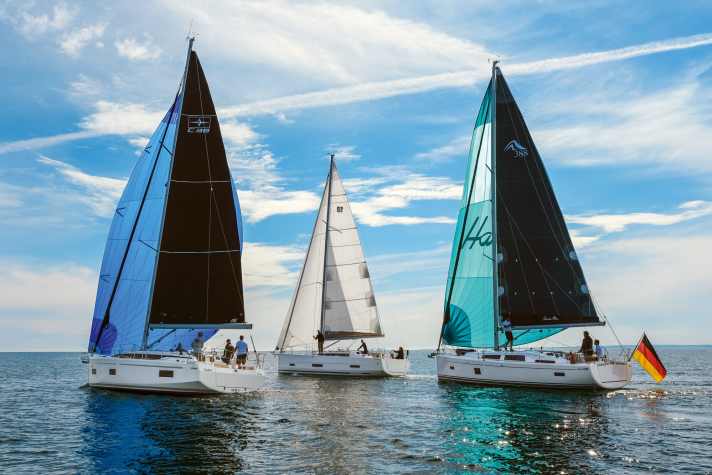
With more wind, however, the tide turns and the picture becomes clearer, this time in favour of the Dufour 390. At the cross, the Frenchwoman can set herself apart from the competition, sails quickly with good height and, above all, is visibly more upright than the Hanse and the Bavaria, which heel more in the same conditions. The Dufour 390 may be the largest of the three, but with a total weight of 7.7 tonnes it is also the lightest boat, which results in better acceleration and good behaviour in the waves.
All cruising yachts show strengths and weaknesses
By comparison, the Bavaria C38 is almost 1.4 tonnes heavier than the Dufour when ready to sail and also tends to feel a little stuck in the waves due to the open bow thruster. The short keel version of the Bavaria also loses height when heading over the ground. On the space sheet course, the Hanse 388 quickly moves into the leading position; with its slim waterline, less wide stern and thus a smaller wetted surface, it can play to its advantages.
Over all: a stalemate in terms of performance under sail. All boats show strengths and weaknesses in different wind forces and angles of incidence. The differences in performance in the test are less likely to be due to the boats themselves, but rather to the different equipment.
Two ways of thinking about deck layout
On the Hanse 388, all sheets, halyards and trim lines are led back to the winches directly in front of the steering columns. Because the shipyard in Greifswald does not offer a genoa as an alternative to the self-tacking jib for this model, the layout generally works well and, above all, is unconditionally suitable for single-handed sailing. However, there are a lot of lines aft of the winches and the sailors have to endeavour to keep them tidy and well organised. However, there are also proper halyards under the seats for the helmsman. Additional winches on the coaming are only intended for gennaker or code zero sheets and are only available as an option.
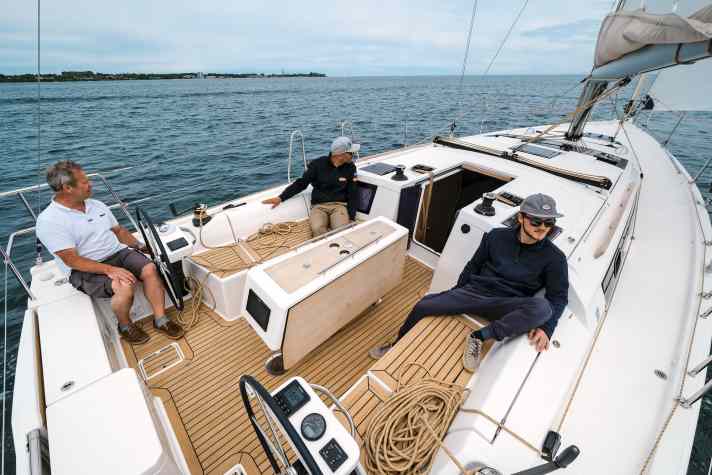
On the Bavaria C38 as well as on the Dufour 390, the mainsheet or sheets for an optional larger genoa can be led aft to the helmsman, which makes the boats suitable for single-handed sailing, albeit only to a limited extent. Halyards and trim lines are operated via the winches to the side of the companionway. The co-sailors crank better and more efficiently than on winches aft on the coaming. The disadvantage of this arrangement is that in practice there is always a lot of loose sheet material on or in the companionway, as there are no designated holds for halyards on either ship. In comparison, the forward cockpit and the companionway of the Hanse remain completely unobstructed and free, which pleases fellow sailors.
Dufour with lots of comfort and standard equipment
The cockpit bays are the largest on the Dufour, with a length of 2.33 metres. Here you can lie stretched out and sunbathe. The benches in the cockpit are shorter on the Bavaria (1.65 metres) and the Hanse (1.60 metres). On the boat from Giebelstadt in particular, however, you sit extremely comfortably, leaning against the ergonomically angled cockpit coaming, which is shaped to fit at the front.
Teak cushions in the cockpit are standard on all three boats. The cockpit table, on the other hand, is only included on the Dufour; Bavaria and Hanse charge extra for it.
The two German shipyards also save on the bathing platform, which is only available at extra cost. The standard boats come without the hatch at the stern, which should actually be part of the basic equipment of a real touring boat these days. On the Dufour 390, however, the platform is not only included in the basic price, it is also the largest in the comparison.
Not much storage space on deck everywhere
When it comes to storage space on deck, the Bavaria C38 scores highly. It offers exclusive space for sails in the forepeak, where, for example, a gennaker in the stocking or a furled code zero can be stored and set directly from there. In addition, the two forecastle boxes in the cockpit are very spacious with large cut-outs for storing bulky items. If the Bavaria is ordered as a two-cabin version, the aft cabin on the port side is used as a large storage space. However, this can only be accessed from the inside; there is no direct access from the cockpit through the cut-out in the cockpit locker, which is the case with the Hanse and Dufour boats.
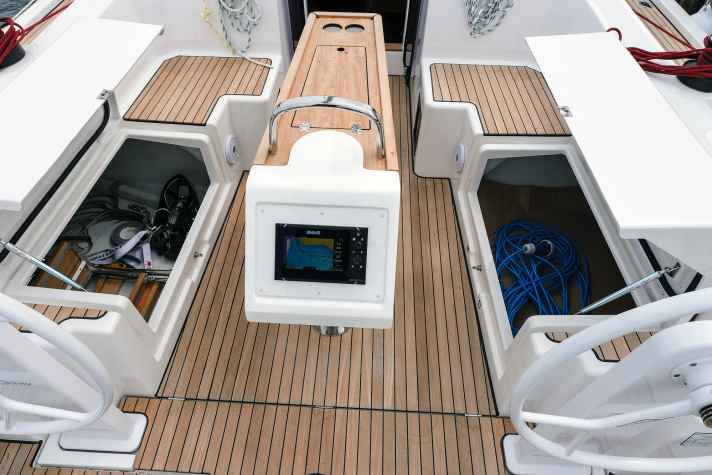
On the Hanse 388, there is only one forecastle on the starboard side. This is the shipyard's way of preserving the ample space in the aft cabin on the port side and not adding to it. If the Hanse is designed with two cabins aft, the amount of stowage space on deck is painfully reduced. The fenders alone then take up a large part of the capacity.
Only the Dufour has a designated storage compartment for the life raft. However, the box is integrated in the stern and can only be reached when the bathing platform is open, which can be difficult in windy and wavey conditions. On the two German boats, the liferaft has to be stored in the forecastle boxes - if there is enough space - or lashed down on deck.
No redundancy in the control systems
Bavaria and Hanse install good, high-quality control systems from Jefa, each with a continuous cable pull. This means that there is no redundancy in the systems. In both systems, however, the autopilot engages directly on the rudder quadrant via a push rod. Should the chain hoists or the steering cable break or the pulleys below deck break, both boats can still be steered, at least with the optional autopilot.
Not so with the Dufour. The Lewmar system also offers no double safety in the event of breakage, with only one continuous cable. And the autopilot in this system is coupled directly to the control cable. The use of the emergency tiller is therefore unavoidable in the event of a system failure. In addition, the mechanics on the Dufour boat are extremely inconvenient to access for repairs and to adjust the cable tension, due to screwed covers in the aft cabin or in the forecastle. On the boats from Germany, the quadrants and cables are much easier to access under easy-to-open flaps in the cockpit.
More powerful engines are worthwhile for all three cruising yachts
All three comparison boats are equipped with a 30 hp built-in engine, saildrive and twin-blade fixed pitch propeller from the shipyard. This standard motorisation seems weak for the rather heavy tourers with a hull length of eleven metres, which even the shipyards confirm and therefore recommend that their dealers offer the boats with a corresponding power upgrade. The boats in the group test are also equipped with this. Bavaria and Hanse have 40 hp common rail diesels from Yanmar, while a 50 hp engine from Volvo Penta is installed on the Dufour as an option.
The investment pays off. All three boats show very good and fast reactions under engine power during manoeuvres in the harbour and accelerate in a straight line both forwards and backwards. The powerful 50 hp engine is particularly noticeable on the Dufour 390, as is the optional three-bladed folding propeller. When the rudder is turned, the comparatively light Frenchwoman reacts somewhat faster than the competitor boats and is easier to manoeuvre in confined spaces in the harbour. The Bavaria and Hanse boats take a little longer to manoeuvre, especially astern, before the rudder takes effect. However, the differences are not great.
Under full load, the Dufour 390 achieves a speed of 8.2 knots in calm and smooth water; at cruising speed (80 per cent of maximum speed) it is 7.6 knots. On the Bavaria C38, the log shows 8.0 knots at full thrust and 7.0 knots at reduced thrust. Despite the engine upgrade, the Hanse 388 is only equipped with a two-bladed folding propeller. This gives her a maximum speed of 7.7 knots (7.3 knots cruising speed).
Full laminate or sandwich in the fuselage
Dufour and Hanse build the hulls of their 38s in hand lay-up as a GRP full laminate with polyester resin. Hanse also uses higher quality vinyl ester resin for the outer barrier layer for better osmosis protection. The hull of the C38 from Bavaria is also made by hand, but as a GRP sandwich construction with a PVC foam core. The boat is only fully laminated below the waterline. Sandwich in the hull generally means stiffer structures, less weight and better insulation.
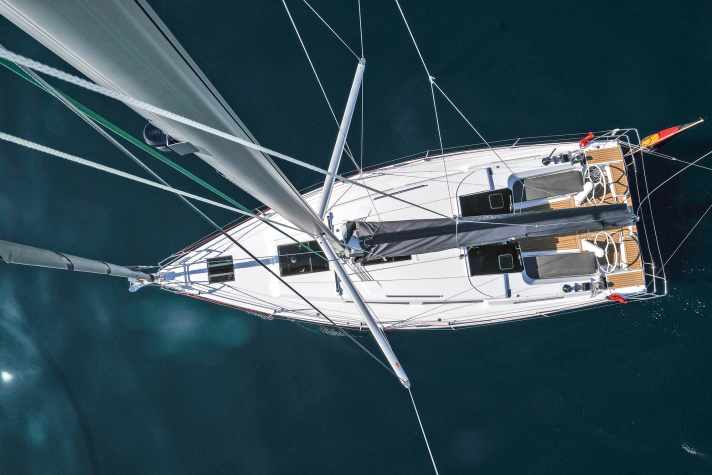
The deck of the Bavaria is made in exactly the same way. Competitors also build the decks of their boats as sandwich constructions with a foam core (Dufour) or balsa wood core (Hanse). The French also use the complex vacuum injection process with RTM technology (Resin Transfer Moulding). With this method, the deck is manufactured in a closed mould, which ensures perfect surfaces on the inside, making the installation of an additional inner shell superfluous. In this way, the shipyard can not only save weight, but also costs. The floor assemblies on all three boats are manufactured as separate structures and subsequently glued into the hull.
After the first part of the comparison test, the protagonists are more or less on a par in the overall assessment, perhaps with certain advantages in favour of the Dufour 390, which is able to convince under sail despite its simple equipment. Whether the Frenchwoman will be able to defend her small lead after the second part remains to be seen.
YACHT rating of cruising yachts around eleven metres
Bavaria C 38
The very modern and full-bodied design with the pronounced chines offers more space on deck and more stowage volume than the competition. Under sail, the ship shows potential, but is undervalued in comparison with a short keel and bow thruster
Design and concept
- + Modern construction
- + Very voluminous hull
- + Sail load in the forecastle
- - Optional cockpit table and platform
Sailing performance and trim
- + Customised layout design
- + Separate tackles for mainsheet
- + Overlapping genoa as an option
- - Slightly slower under machine
- - Single-handed only with extras
Dufour 390
In windy conditions, the attractive Frenchwoman benefits from low weight and a balanced sail plan with a self-tacking jib. She is the slightly faster boat in the group test upwind and also sails visibly stiffer. The concept is coherent and well thought out
Design and concept
- + Lightest ship in comparison
- + Large cockpit, long dikes
- + Storage space for life raft
- - Control poorly accessible
Sailing performance and trim
- + Fast and high in the wind
- + Good handling with crew
- + Overlapping genoa as an option
- - Short J-measure, small jib
- - Backstay tensioner only as an extra
Hanse 388
As a revision of the 385, the Hanse 388 is based on the oldest design in the comparison. Her lines are therefore more moderate and less radical, which particularly benefits her appearance. The deck layout impresses with its extremely practical handling
Design and concept
- + Visually harmonious design
- + Comfortable seating positions in the cockpit
- - Optional cockpit table and platform
- - Less storage space on deck
Sailing performance and trim
- + Good performance, especially on the downwind side
- + Consistently suitable for single-handed use
- + backstay tensioner as standard
- - No larger genoa possible
- - No bowsprit as an option
Key figures and measured values of the cruising yachts
Potential

Dimensionless key figure that sets the sail area in relation to the displacement. The higher the value, the higher the theoretical performance potential
1: Dimensionless number. Calculation: 2√S/3√V. The higher the value, the more sail area (S) the ship has in relation to the displacement (V)
Ballast proportion (standard keels)

Ratio of keel ballast to total weight. The higher the proportion of ballast, the greater the righting moment. Dimensional stability is not taken into account
Length to width ratio

The numbers express the aspect ratio of a yacht. Higher values stand for a slender boat, lower numbers describe wide, voluminous cracks
Hull weight per metre

Total weight minus ballast divided by the length in metres. The value indicates how heavy a ship (without keel, but with interior) is built
Freeboard heights
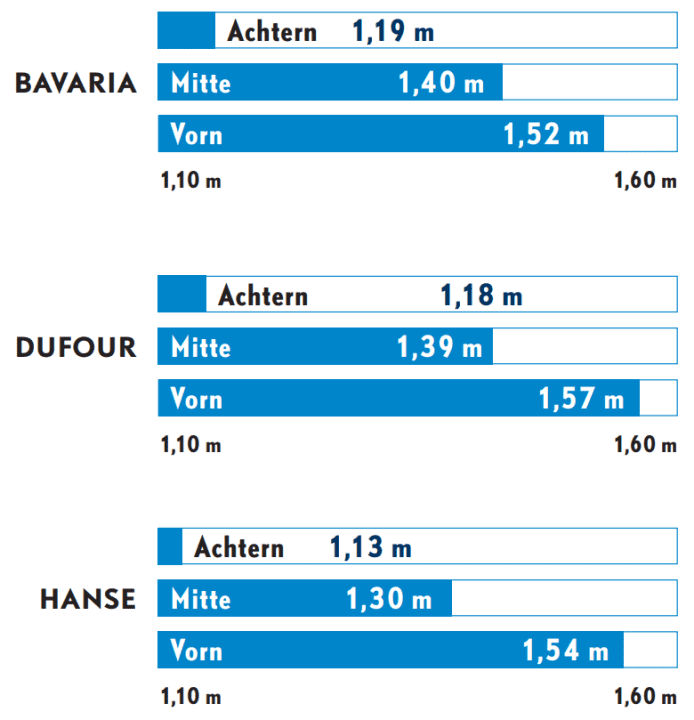
Hull height above the waterline. Measured at the stern (aft), at the height of the shrouds (centre) and directly at the stem (forward)
Technical data of the cruising yachts
Bavaria C38
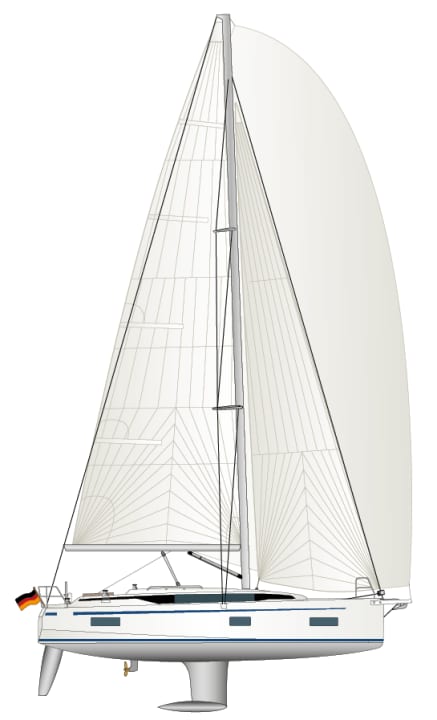
- Designer:Cossutti Y. D.
- CE design category: A
- Torso length: 10,99 m
- Total length:11,38 m
- Waterline length: 10,28 m
- Width: 3,98 m
- Draught/alternative: 2,05/1,65 m
- Theoretical torso speed: 7.8 kn
- Weight: 9,1 t
- Ballast/proportion: 2,2 t/24 %
- Mast height above waterline: 18,57 m
- Mainsail: 46,0 m2
- Self-tacking jib: 28,5 m2
- machine (Yanmar): 21 kW/29 hp
- Fuel tank: 210 l
- Fresh water tank: 210 l
- Holding tank: 70 l
Hull and deck construction
GRP sandwich construction with foam core, E-glass and polyester resin. Built in hand lay-up
Dufour 390
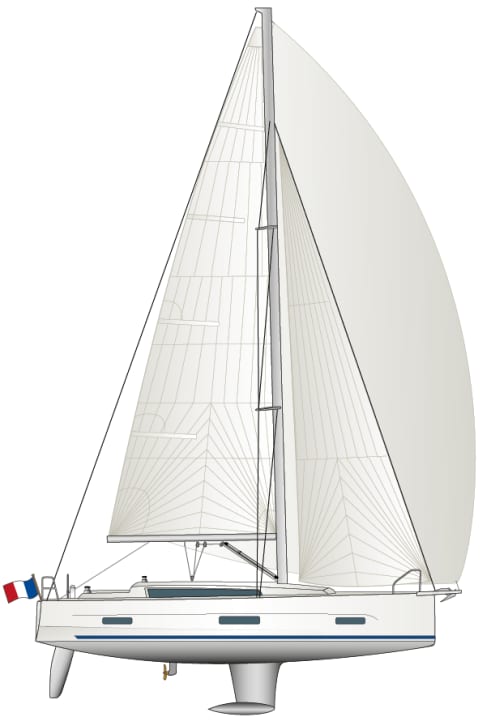
- Designer: Felci Yacht Design
- CE design category: A
- Torso length:11,20 m
- Total length:11,94 m
- Waterline length:10,50 m
- Width: 3,99 m
- Draught/alternative: 1,95/1,75 m
- Theoretical torso speed:7.9 kn
- Weight:7,7 t
- Ballast/proportion: 2,1 t/27 %
- Mast height above waterline: 17,60 m
- Mainsail: 36,6 m2
- Self-tacking jib: 29,9 m2
- machine (Volvo Penta): 22 kW/30 hp
- Fuel tank: 200 l
- Fresh water tank: 200 l
- Holding tank: 50 l
Hull and deck construction
- Hull: GRP full laminate in manual support.
- Deck: GRP sandwich with foam core, built with vacuum injection
Hanse 388
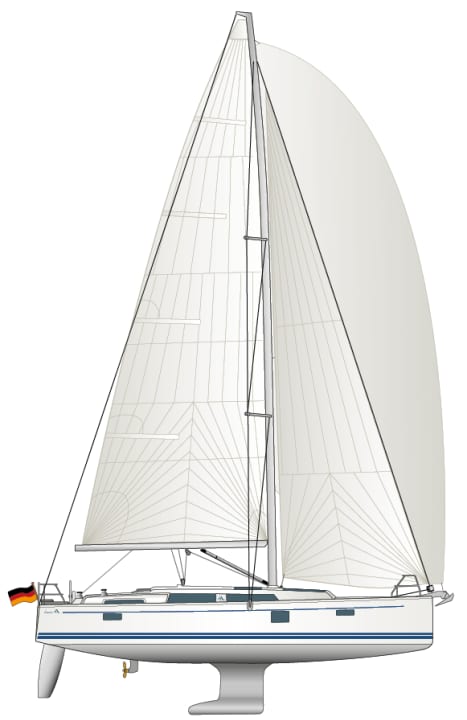
- Designer: Judel/Vrolik & Co.
- CE design category: A
- Torso length: 10,99 m
- Total length: 11,40 m
- Waterline length: 10,40 m
- Width:3,90 m
- Draught/alternative: 2,06/1,62 m
- Theoretical torso speed:7.8 kn
- Weight: 8,3 t
- Ballast/proportion: 2,4 t/29 %
- Mast height above waterline:17,60 m
- Mainsail: 41,2 m2
- Self-tacking jib: 27,8 m2
- machine (Yanmar):21 kW/29 hp
- Fuel tank: 160 l
- Fresh water tank: 295 l
- Holding tank: 64 l
Hull and deck construction
- Hull: GRP full laminate in manual support.
- Deck:GRP sandwich with balsa wood core. Vinyl ester for outer layers
This article first appeared in YACHT 14/2021 and has been revised for this online version

